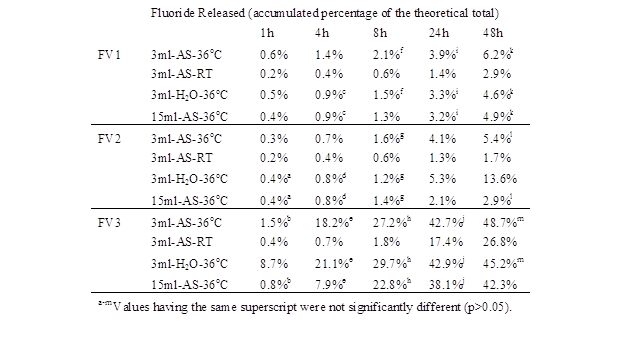Objectives: To evaluate the effects of temperature, medium and volume on fluoride release of different fluoride varnishes in vitro.
Methods: Fluoride release from 5%NaF varnishes [Duraphat-Colgate (FV1), Vanish-3M (FV2), EnamelPro-Premier (FV3)] was determined in three independent experiments (one per varnish). Each varnish was mixed well, applied to 40 custom-made holders (14-16 mg/holder) and divided into four groups (n=10). A control group was incubated at 36oC in 3ml of stirring artificial saliva (AS; ionic strength similar to human saliva). Each of the other groups changed one variable: temperature (to ~25°C), medium (to H2O) or volume (to 15 ml). After 1, 4, 8, 24 and 48h, varnish holders were transferred to fresh media. Fluoride concentration was measured in the liquids from each time period. Accumulated fluoride released, as a percentage of the theoretical amount present in each sample, was calculated and statistically analyzed using ANOVA models.
Results: The three factors studied significantly affected fluoride release (p<0.05). Lower temperature was the major factor, decreasing release from all three varnishes. For FV2, H2O medium increased the fluoride release dramatically after 24h.
Conclusion: Results of this investigation strongly suggest that incubation conditions significantly affect the amount of fluoride released from varnishes in vitro. The magnitude of this effect differed for various types of fluoride varnishes.
Keywords: Cariology, Fluoride, Preventive dentistry and Varnish
See more of: Cariology Research - Fluoride and Ca-based Products
![[ Visit AADR's Website ]](images/banner.jpg)
